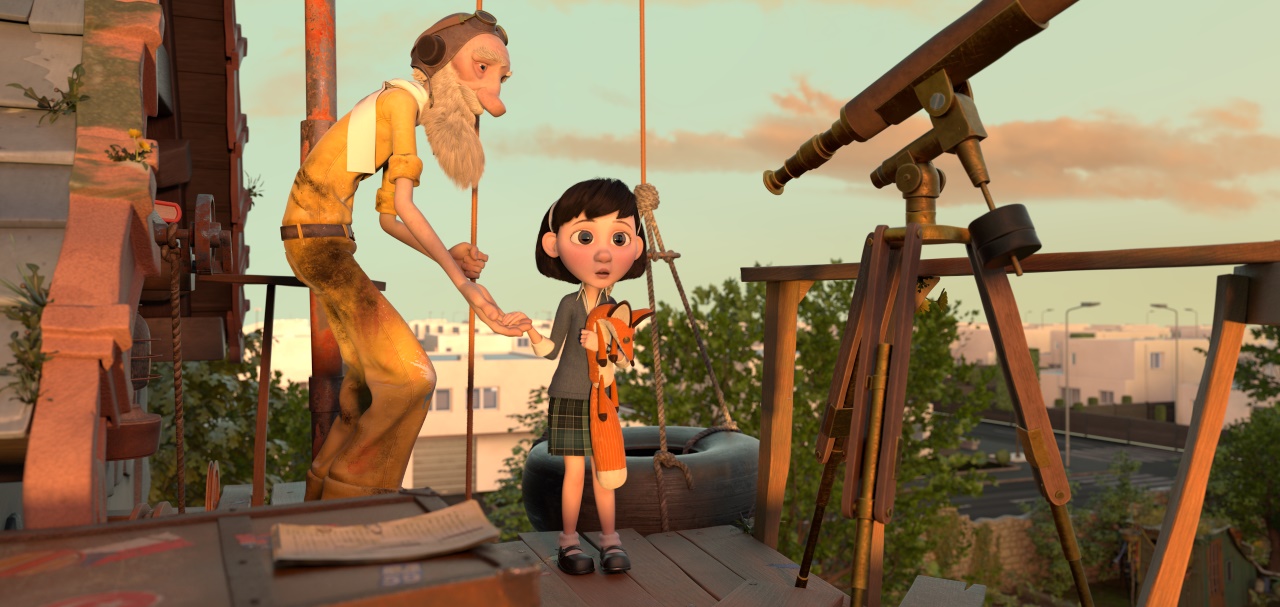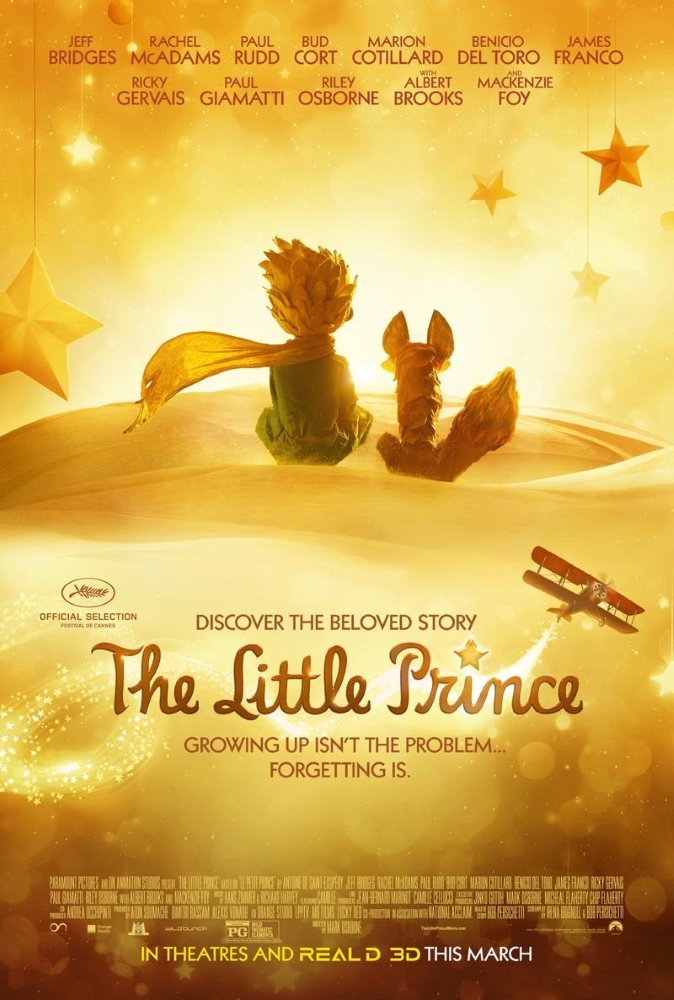Crew
Director – Mark Osborne, Screenplay – Irena Brignull & Bob Perischetti, Based on the Book The Little Prince (1943) by Antoine de Saint-Exupery, Producers – Dimitri Rassam, Aton Soumache & Alexis Vonarb, Music – Richard Harvey & Hans Zimmer, Stop-Motion Creative Director – Jamie Caliri, Visual Effects Supervisor – Pascal Bertrand, CG Animation Supervisor – Jason Boose, Production Design – Lou Romano, Stop-Motion Production Design – Alexander Juhasz. Production Company – Orange Studio/Wild Bunch/On Animation Studios/LPPTV/M6 Films/Canal+/M6/W9.
Cast
Mackenzie Foy (The Little Girl), Jeff Bridges (The Aviator), Rachel McAdams (The Mother), Riley Osborne (The Little Prince), Paul Rudd (Mr Prince), Albert Brooks (The Businessman), James Franco (The Fox), Marion Cotillard (The Rose), Ricky Gervais (The Conceited Man), Benicio Del Toro (The Snake), Paul Giamatti (The Academy Teacher), Jeff Branion (The Policeman)
Plot
A little girl has her whole life mapped out for her by her mother in terms of what she needs to do to succeed. When she fails to be accepted into the prestigious Werth Academy, her mother decides the only recourse is to move into the school district. She buys a house next door to a ramshackle old home. The little girl is drawn to the eccentric old man who lives there and keeps a biplane in his backyard. He gives her pages of a story he has written about what happened to him as a young man when his plane crashed and he was stranded in the Sahara Desert. There he encountered a Little Prince from the tiny Asteroid B-612 who had come to Earth in search of a sheep. Along the way, the Little Prince encountered many strange and interesting people. As she reads, the little girl is affected by the story of the Little Prince but begins to ignore the strict schedule her mother has mapped out for her in order to spend more time with The Aviator.
Antoine De Saint-Exupery (1900-44) is considered a French national icon. Saint-Exupery was a pilot during the infancy of commercial flight in the 1920s, where he flew as an international postal courier and later managed an airfield in the Sahara. He began writing in 1926 and within his lifetime published seven books, all on aviation themes, both fictional and autobiographical works. Saint-Exupery is a character of some interest. Chief among these is the mystery of his eventual fate – he joined the French Air Force during the Second World War. In 1944, he flew what was meant to be his last mission, a reconnaissance flight, before leaving the service, but failed to return. Exactly what happened remains a mystery, although it is generally believed that he was shot down by a German fighter. Largely on the basis of The Little Prince, he has become a celebrated figure in French culture. He appeared on the French 50 franc note and has had an airport (in Lyon) and even an asteroid named after him.
The most famous of Saint-Exupery’s works is Le Petit Prince/The Little Prince (1943), which has gone onto become an international children’s classic. The story is largely seen as allegorical upon Saint-Exupery’s part – he, like the character, was a pilot in Saharan Africa, crashlanded in the desert in 1935 and was stranded for several days during which he experienced hallucinations. The character of The Rose, who represents the Prince’s petulant love, was a portrait of his wife Consuelo – she later entitled her autobiography The Tale of the Rose (1979). The characters throughout stand in for allegorical caricatures of various types in modern society, against whom the Prince represents an unalloyed innocence. When it was published, The Little Prince had the distinction of being sold as both an adult work and a children’s story.
There have been a number of tv, audio and stage adaptations of The Little Prince. The most famous on movie screens has been The Little Prince (1974), a musical version from Stanley Donen with a score by Lerner-Loewe and starring Bob Fosse as The Snake and Gene Wilder as The Fox, among others. A far more impressive version of the story was a short film version made by Claymation animator Will Vinton in 1979. There was also an anime tv series The Adventures of the Little Prince (1978-9), a further animated adaptation made for German tv in 1990 and a French animated tv series in 2010.

This new version comes from a consortium of French companies, although is directed by US animator Mark Osborne. Osborne first directed the live-action sequences of The Spongebob Squarepants Movie (2004) and then co-directed DreamWorks’ Kung Fu Panda (2008). Osborne made much of how The Little Prince was a personal story to him in that it formed a link between he and his wife while they were dating as students but separated by long distance. The film had a successful international screening in various countries throughout late 2015, although was withdrawn from US theatrical release without any reason given less than a week before it was due to open in March 2016 and dumped to Netflix.
The confusion in watching The Little Prince as it opens is in seeing familiar bits of the story alongside a good many unfamiliar bits that have nothing to do with the book. For instance, there is no Little Girl and her story in the book and yet she is the central character of the film. The Saint-Exupery story takes place in the Sahara Desert and yet the bulk of the film takes place in a stylised representation of contemporary suburban America. There is nothing in the book about The Aviator being an eccentric old man; he is merely a pilot who has crashlanded. The book tells the story of the Little Prince’s journey through space and his meeting The Aviator and various animals in the Sahara Desert. These scenes do occur in the film but are relegated to a fairly minor place and told as flashback as the Little Girl reads the story.
What the film has gained is another much larger story that has nothing to do with the one that takes place in the book in which the aging Aviator opens up The Little Girl’s rigidly pre-planned world, as well as the later scenes where she goes on an adventure and encounters a grown-up version of The Little Prince who is now working as a janitor and inspires him to remember who he was.

All of this is puzzling especially in that Mark Osborne made a great deal in the pre-release publicity about how he wanted to respect the original. He certainly gives the elements and characters life. However, I would question whether boilerplating on another complete story that creates simplistic divides between conformity and imagination and turns the Little Prince into a bumbling janitor who has forgotten who he was is really being faithful to what Antoine de Saint-Exupery wrote.
What we have feels like a completely different story that has occasional Little Prince interludes. Saint-Exupery was making a fable about the unfettered imagination, a belief in the essence of invisible things and thinking outside the box (as perfectly illustrated by the opening sketch of the snake swallowing an elephant); what Mark Osborne seems to be making a film about is how everybody in the modern world conspires to grind down the imagination.
On the plus side and seen on its own terms, Mark Osborne delivers a frequently very lovely film. Both the stylised representation of the world and the often tender and appealingly gentle touches that he adds in all manner of places give it a soft emotion. There are times the film deals with some strong grown-up feelings, including the looming presence of death, for a film that has been pitched to family audiences.


